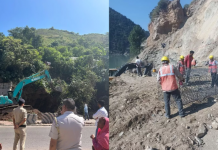According to the South Asia Terrorism Portal (SATP), around 45 people have died in Kashmir until the first week of March this year — 23 of them militants, 15 security personnel and seven civilians. As is self-evident, despite the claims to the contrary, there has been no let-up in the troubled security situation in the state. Nor is there a reason to foresee a degree of stability in the near term.
What is more, a growing challenge of the militancy in the state has been complemented by the worsening situation on the borders. In a development that shows an expanding arc of the conflict, the recurrent exchange of firing along the Line of Control (LoC) and the International Border (IB) in Jammu has now spread out to the border in Kashmir. In the recent past, the LoC along Hajipeer and Uri in North Kashmir has flared up, leading to migration of the border residents to safer areas. This is the first time after the 2003 ceasefire agreement that the ceasefire vi olations have returned to the border in Kashmir with such frequency and ferocity.
olations have returned to the border in Kashmir with such frequency and ferocity.
Again, according to SATP, there have been 120 ceasefire violations along the LoC and the IB in January and February, leading to the killing of 11 security personnel and ten civilians on the Indian side. Going forward, there is little hope that things will improve.
Internally, the militancy is showing no signs of abating anytime soon. According to a recent security estimate, the number of active militants in the Valley is 229, more or less same as in the beginning of 2017. This despite the fact that 218 militants were killed in counter-insurgency operations during the last year.
So, there is little that has changed on the militancy front. The number of the militants the security forces were up against in 2017 is also the number they are up against in 2018, killings notwithstanding. What is more, if in 2016 security forces were fighting just two militant organizations — Hizbul Mujahideen and Lashkar-e-Taiba — now they are fighting six of them. The Valley has witnessed surfacing of the outfits like Jaish-e-Mohammad, Al Qaeda, Harkat-ul-Mujahideen and Tehreek-ul-Mujahideen. That is, if we discount ISIS’ claim of having set its foot in Kashmir. ISIS has so far owned two attacks in the Valley: one, the killing in February of a police man guarding the residence of senior Hurriyat leader Fazal Haque Qureshi. And another of an SHO who was killed in November in a shoot-out at Zakura on the outskirts of Srinagar.
On both the occasions, the J&K Police denied the existence of the group in the state. And when, following the latest ISIS claim of responsibility, the J&K DGP SP Vaid told a national television channel that the global Jihadi group did operate in the Valley, the ministry of home affairs promptly issued a denial. Later, the DGP also went back on his statement.
However, whatever be the reality of the ISIS or Al Qaeda’s presence in Kashmir, the truth is that the situation in the state is going through accelerating deterioration. The lingering violence in the state is the latest reminder to the effect. The scenario for the year ahead is thus very bleak. Local recruitment complemented by infiltration is likely to ensure a violent summer. At the same time, the recurrent border flare-ups will keep alive the possibility of a bigger conflict between the neighbours. “If anything, this state of affairs underlines the futility of the muscular approach adopted by New Delhi in Kashmir,” says Naseer Ahmad, a local columnist. “And if anything, the rising violence in Kashmir and on the borders emphasizes the importance of dialogue and engagement between India and Pakistan.”
letters@tehelka.com













